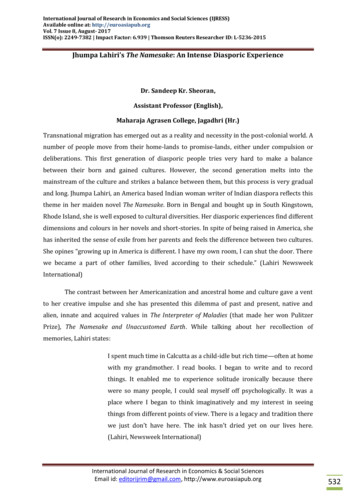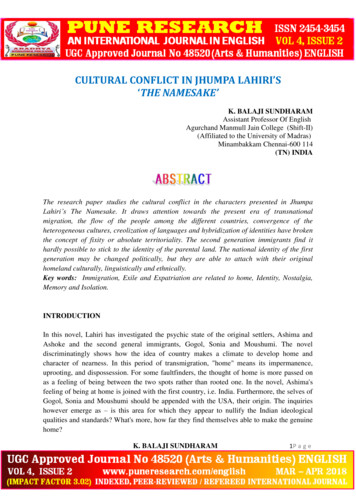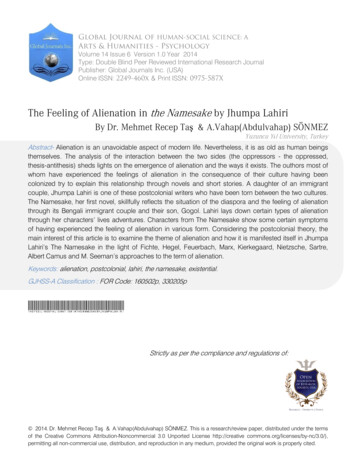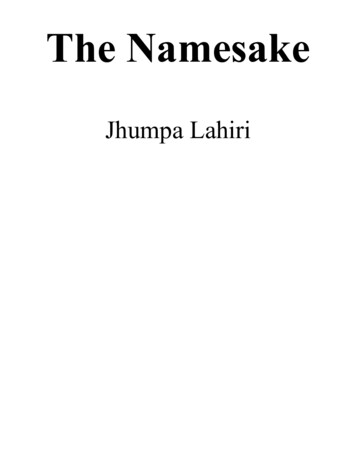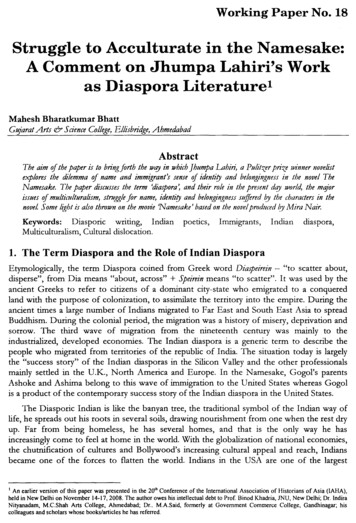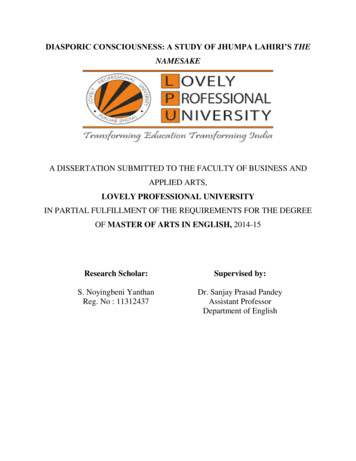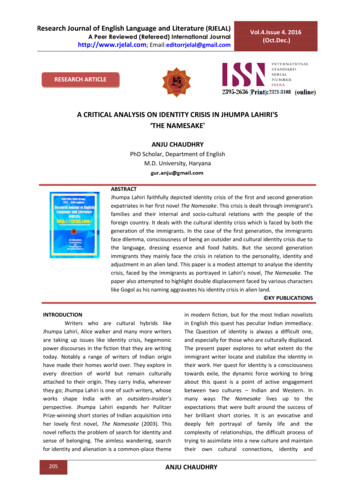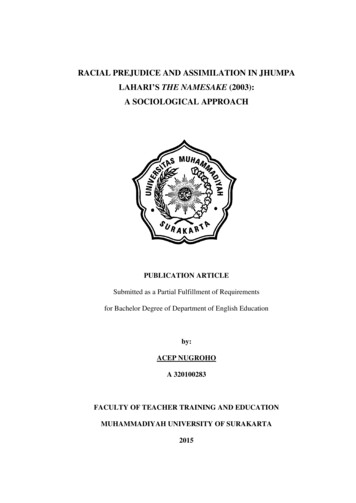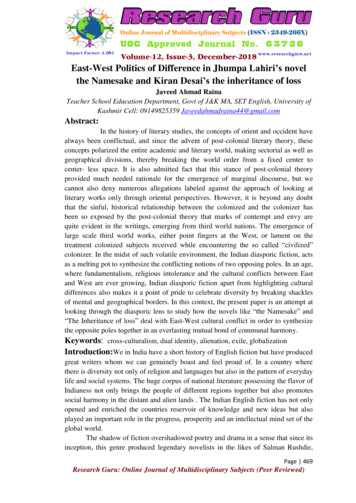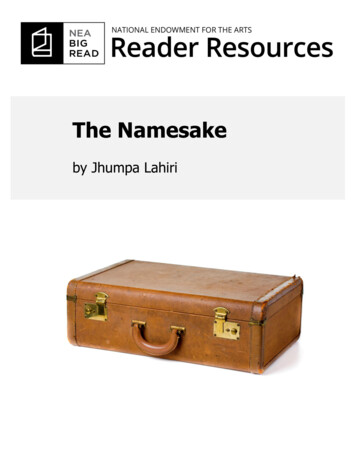
Transcription
The Namesakeby Jhumpa Lahiri1
Table of ContentsThe NamesakeAbout the Book. 3About the Author . 4Historical and Literary Context . 6Other Works/Adaptations . 8Discussion Questions. 9Additional Resources . 10Credits . 11“That’s the thingabout books. Theylet you travelwithout moving yourfeet.”PrefaceWhat's in a name? For Gogol Ganguli, American-born ofBengali parentage bearing a Russian writer's surname, thisquestion is neither easily answered nor easily dismissed.Straddling two generations, two cultures, and with two firstnames, Gogol moves through life with a sense he neverquite fits in. His quiet angst and personal questioning almostderail him, careening–like the train that links him to hisfather and his destiny—from relationship to relationship.Jhumpa Lahiri's understated exploration of identity andcultural assimilation in The Namesake illuminates for us allthe question "Who am I?," while bringing alive the colors,flavors, and textures of immigrant Indian life in America.What is the NEA Big Read?A program of the National Endowment for the Arts, NEA BigRead broadens our understanding of our world, ourcommunities, and ourselves through the joy of sharing agood book. Managed by Arts Midwest, this initiative offersgrants to support innovative community reading programsdesigned around a single book.A great book combines enrichment with enchantment. Itawakens our imagination and enlarges our humanity. It canoffer harrowing insights that somehow console and comfortus. Whether you’re a regular reader already or making upfor lost time, thank you for joining the NEA Big Read.NEA Big ReadThe National Endowment for the Arts2
About the BookIntroduction tothe BookA father and mother, a sonand daughter: two generationsof a typical Bengali–Americanfamily, poised uneasily atopthe complex and confoundingfault lines common to theimmigrant experience. JhumpaLahiri's novel The Namesakedeftly demonstrates how thefamiliar struggles between newand old, assimilation andcultural preservation, strivingtoward the future and longing for the past, play out in oneparticular set of foreign-born parents and their Americanborn children.In the novel's opening pages, Ashima Ganguli, who left Indiato join her husband Ashoke in America, is about to delivertheir first child, a son. Following Bengali custom, the child isto have two names—a pet name, for use only by family andclose friends, and a "good" name, to be used everywhereelse. Almost by mistake, the boy comes to be known asGogol, named for his father's favorite Russian author. In aharrowing flashback, the reason for Ashoke's attachment tothe Russian writer is revealed.Gogol's father embraces their new life, while his motherlongs for her homeland. As Gogol enters school, theyattempt to convert his unusual name to a more typical one,but the boy stolidly rejects the transition, refusing tobecome, as he thinks of it, "someone he doesn't know."Soon he regrets his choice, as the name he's held ontoseems increasingly out of place.The novel's finely wrought descriptions of Bengali food,language, family customs, and Hindu rituals draw us deepinside the culture that Gogol's parents treasure whilehighlighting his alienation from it. Gogol finishes school,becomes an architect, falls in love more than once, andeventually marries, without ever fully embracing hisheritage. His decades-long unease with his name is a perfectdistillation of the multiple dislocations—cultural, historic, andfamilial—experienced by first-generation Americans. At thenovel's climax, when loss compounds loss and Gogol's familystructure is forever changed, he begins to understand, atleast in part, his parents' longing for the past, and thesacrifices they made to help him be what he is—trulyAmerican.NEA Big ReadThe National Endowment for the ArtsMajor Characters in the BookAshoke GanguliA Bengali man who comes alone to the U.S. to studyelectrical engineering. Weds Ashima Bhaduri via an arrangedmarriage in Calcutta. Father of Gogol and Sonia, a dedicatedbut undemonstrative family man with a lifelong attachmentto Russian literature.Ashima GanguliJourneys alone to the U.S. shortly after marrying Ashoke.Caring mother to Gogol and Sonia; stays in close touch withher family in India and maintains a growing network ofBengali friends and neighbors, as her family moves from cityto city for Ashoke's career. At the end of the novel shebifurcates her life to spend time in the U.S. with her childrenand in India with her family of origin.Gogol GanguliThe "namesake" of the title, named after his father's favoriteRussian writer, Nikolai Gogol (1809–1852). A first–generation Indian American whose uneasiness with his nameexemplifies his difficulties in fitting in, either to his parents'expatriate world or to the world inhabited so comfortably byhis American peers.Sonia GanguliGogol's younger sister, who is less troubled than he by theirshared cultural heritage, or by the strictures and oddities oftheir household. Her steadiness—a peaceful life with hermother after her father's death, and a happy marriage—throws Gogol's chronic discomforts into sharper relief.Maxine RatliffThe only child of wealthy, urbane New Yorkers, and Gogol'sfirst post–college girlfriend. Maxine represents so manythings that Gogol believes he values: art and music,sophistication, and ease in the world.Moushumi MazoomdarAppears first as the book-reading child of a neighboringBengali family, noteworthy only because of her aloof air anddeliberate English accent. The adult Moushumi resurfaces asGogol's love interest and eventual wife. She too stages arebellion against her heritage, living alone in Paris for a time.3
About the AuthorJhumpa Lahiri(b. 1967)Jhumpa Lahiri was born inLondon to Bengali émigréparents in 1967. When shewas three, her family movedto South Kingstown, RhodeIsland, where her father wasa librarian and her mother ateacher.Like her character Gogol,Lahiri experienced someconfusion over her namewhen starting school. HerJhumpa Lahiri. Photo by Elenaparents tried to enroll herSeibert.using her "good" names—Nilanjana and Sudeshna—but the teacher insisted that thosewere too long, and opted instead for her pet name, Jhumpa.Lahiri notes that, "Even now, people in India ask why I'mpublishing under my pet name instead of a real name."Lahiri began to write at age seven, sometimes creating shortfiction pieces with her friends during recess. She later wrotefor the school newspaper. She received her undergraduatedegree from Barnard College, then moved to Boston toattend Boston University, from which she received threemaster's degrees—in English, comparative literature, andcreative writing—and a PhD in Renaissance studies.While in Boston, she worked in a bookstore and interned ata magazine; she has noted that, had she stayed in NewYork, she might have been too intimidated to write: "In NewYork I was always so scared of saying that I wrote fiction. Itjust seemed like, 'Who am I to dare to do that thing here?The epicenter of publishing and writers?' I found all thatvery intimidating and avoided writing as a response."Lahiri received a fellowship from the Fine Arts Work Centerin Provincetown from 1997 to 1998. In 1998, The NewYorker magazine published "A Temporary Matter," one ofthe stories that would appear in her first collection,Interpreter of Maladies. In 2000, the collection won thePEN/Hemingway Award for the year's best fiction debut, andwas awarded the Pulitzer Prize for Fiction. She is the firstIndian-American woman to receive this award.In 2003, she published The Namesake, a novel, and followedthat in 2008 with a second collection of short stories,Unaccustomed Earth. Next she wrote The Lowland (2013)and a memoir—written in Italian—In Other Words (2016).Lahiri and her husband Alberto Vourvoulias-Bush have twochildren.NEA Big ReadThe National Endowment for the ArtsAn Interview with Jhumpa LahiriOn February 14, 2013, Josephine Reed of the NationalEndowment for the Arts interviewed Jhumpa Lahiri. Excerptsfrom their conversation follow.Josephine Reed: How would you describe the plot of TheNamesake?Jhumpa Lahiri: It's about the process of becomingAmerican, understanding the ways in which that's possible.The heart of the book is about a family's relationship toAmerica and to the change that inevitably happens when aperson leaves one's place of origin and arrives in a newworld, which is very much an American story.JR: We see an uncertainty about identity filtering down tothe next generation in The Namesake, in Gogol.JL: Gogol is very typical in wanting to be American. I thinkmost young people just want to conform on some level, andthen they stop wanting to conform and maybe become moreinteresting; but there's a stage of simply wanting to beaccepted and not questioned. [Gogol's parents] may be lost,and they may be homesick, but they never doubt for amoment where home is—whereas for Gogol that sense ofhome is not fixed because India is not his home, andAmerica is not yet his home.JR: Issues of identity play out in his relationship with hisparents—he sees them as foreign, and that's troubling tohim. Can you talk about some of that tension?JL: I can speak maybe just from my own experience. I thinkmy impulse as a child was to protect my parents from what Iperceived as sort of ignorance. But the other emotion was afrustration with them, because I wasn't there to protectthem; I was their child, and I wanted them to protect me. Itcreates a strange dynamic when you speak the languagebetter than your parents, when you go into stores andyou're a child and they ask you what kind of washingmachine your parents are interested in because they don'ttrust your parents to articulate themselves. These kinds ofthings can be very troubling, they're frustrating, they mademe angry, they made me sad, they made me overprotectiveof my parents, concerned for them and also frustrated thatthey weren't more seemingly capable.JR: Names, as the title of your book suggests, areimportant. Can you explain pet names in the Bengalitradition as opposed to the "good" name?JL: I think the pet name is very much connected to one'sformative years and childhood and affection. And one'smother and father would never, ever, ever, ever useanything but a pet name for one's child. You tend to go to4
school with your good name and what ends up happening isthat you've got two names to represent the sort of homeversion, the more intimate version, versus the out-in-theworld, being-educated, working-at-a-job version—the formalversion, as it were, versus the informal.JR: When Gogol goes to school, his father tells him the"good" name that he's chosen for him, which is Nikhil.JL: I think in an American context, it would be doublydisconcerting to suddenly enter school and be told by yourparents, "Oh, by the way, not only are you going to spendall day away from us in the company of a teacher you'venever met and don't know, but she's going to call you thisother name." I imagine that would be very distressing to anychild.JR: Can you touch on the sense of displacement the Gangulifamily experiences?JL: Gogol's parents appear most at home when they goback to Calcutta, where there is a certain sort of blissfulabandonment of a.level of anxiety and uncertainty thatthey carry with them as foreigners. I think it's impossible,virtually impossible, to live as a foreigner in any country. Nomatter how at ease, affluent, educated, articulate you are.When it's not your place, it's not your place.NEA Big ReadThe National Endowment for the Arts5
Historical and Literary ContextThe Life and Timesof Jhumpa Lahiri1990s 1990: The Census counts more than 450,000 Indianimmigrants living in the U.S. 1993: Lahiri receives an MFA from Boston University'sCreative Writing Program.1940s 1947: British India divided into two sovereign nations,India and Pakistan. 1999: Lahiri publishes first short story collection,Interpreter of Maladies.2000s1950s 1950: The Indian government outlaws the castesystem. 1952: The Immigration and Nationality Act of 1952,also known as the McCarran-Walter Act, targetsimmigrants who support communism or anarchy. 1957: Dalip Singh Saund elected the first IndianAmerican voting member of U.S. Congress.1960s 2000: Interpreter of Maladies wins Pulitzer Prize forFiction. 2003: The Namesake published. 2006: The Namesake made into a major motionpicture directed by Mira Nair. 2006: Lahiri receives NEA Literature Fellowship. 2007: Bobby Jindal elected the first Indian-Americangovernor (of Louisiana). 2008: Lahiri publishes second short story collection, 1965: U.S. Immigration and Nationality Act of 1965liberalizes immigration. 1966: Indira Gandhi elected India's Prime Minister. 1967: Jhumpa Lahiri born in London.Unaccustomed Earth.2010s 2010: Lahiri serves as consultant to the HBO series InTreatment.1970s 1970: Jhumpa Lahiri and her family move to RhodeIsland. 1970: America's first Hindu temple built in Flushing,New York. 2010: Nikki Haley elected the first Indian-Americanfemale governor (of South Carolina). 2012: Lahiri named to the American Academy of Artsand Letters. 1971: East Pakistan becomes Bangladesh1980s 1980: The United States Refugee Act of 1980 raisescap on annual admission of refugees to 50,000 peryear. 1984: Indira Gandhi assassinated. 1989: Lahiri graduates from Barnard College.NEA Big ReadThe National Endowment for the Arts6
The Indian Immigration ExperienceThe U.S. Immigration and Nationality Act of 1965 liberalizedAmerica's immigration laws by replacing quotas based onnational origin with a greater emphasis on familyrelationships and the need for highly skilled immigrants.These changes helped accelerate the pace of Indianimmigration to the U.S. Today, Indian Americans are thecountry's third-largest population of Asian ancestry, afterChinese Americans and Filipino Americans. In 2010 nearlythree million Indian immigrants lived in the U.S.Indian immigrants to the U.S. tend to be highly educated;almost 67 percent have at least a bachelor's degree, andnearly 40 percent have a graduate degree. Indian Americanshave a disproportionate presence in professions such asengineering, technology, and medicine. India's vasteducation system produces tens of thousands of engineeringand technology graduates each year, and English is widelytaught in Indian schools.Prominent Indian-American businessman Vivek Wadhwanoted in Businessweek that most Indian immigrants arrivedin the U.S. relatively recently, after 1980. He attributes theirsuccess in part to the competitiveness of the Indianeducation system, which teaches hard work at an early age.He also credits the entrepreneurial spirit and acceptance ofother cultures that arise from living in a sprawling, underresourced country that includes six major religions and 22languages.about her religion and cultural heritage, bringing her countryof origin "into the spotlight" in positive ways.An Indian immigrant family arriving in the U.S. in 1970would have had many more reasons to feel isolated than afamily arriving today. The first Hindu temple in the U.S., builtin Flushing, New York, didn't open until 1970. Today thereare hundreds throughout the country, in big cities likeChicago and also in smaller population centers. "Bollywood"films, Hindu-language movies created in Bombay's thrivingfilm industry, often play in theaters dedicated exclusively tosouth-Indian films; the United States is by far the largestexport market for these movies. The Internet and moreaccessible telecommunications tools have made it possiblefor families to stay in touch across long distances and manytime zones, and the same technologies have exposedmillions of Americans to Indian cuisine, dress, architecture,and societal customs.Today, from spices and textiles, to music and art, India is avisible and vibrant aspect of American life. Due in part todecades of successful immigration, India's presence in theU.S. is also recognition of the tremendous contributionsmade by Indian Americans to U.S. business, technology,education, and culture.Indian immigrants who come to the U.S. for higher wagesand broader career options also expect their children to takefull advantage of American education. A 1992-96 study inCalifornia demonstrated that Indian-American students excelacademically, outperforming most other immigrant groups.But many young Indian Americans also report some degreeof cultural dislocation, deploying the acronym "ABCD," or"American-Born Confused Desi," to describe themselves andtheir experience. (Desi refers to second-generation SouthAsians.)In a 2009 essay contest conducted by the Hindu AmericanFoundation, one such young writer compares herself tosuperheroes like Batman and Wonder Woman, owing to her"double life" straddling both her parents' distant world andthe Minneapolis suburb where she grew up. She also notesthat Hinduism, as one of the world's oldest religions,contains elements of many other faiths, and so to be aHindu in America is to experience "a melting pot within amelting pot." Finally, she points out that recent films such asBend It Like Beckham (2002) and Slumdog Millionaire (2008)have provided an opportunity for Americans to learn moreNEA Big ReadThe National Endowment for the Arts7
Other Works/AdaptationsLahiri and Her Other WorksJhumpa Lahiri's novel The Namesake, published in 2003, ispreceded and followed by two highly acclaimed short storycollections: Interpreter of Maladies (1999) andUnaccustomed Earth (2008).Winner of the Pulitzer Prize for Fiction and thePEN/Hemingway Award, Interpreter of Maladies was alsonamed The New Yorker's Best Debut of the Year, and is onOprah Winfrey's Top Ten Book List. Six of the stories are setprimarily in America, while three are set in India. The storiesbased in the U.S. focus on themes familiar to readers of TheNamesake: the characters' cultural displacement, theirdistrust of American society, and the chronic missedconnections between first- and second-generation Indianimmigrants.Many of Lahiri's stories include an embedded travelnarrative. Whether transported across the country or aroundthe world, Lahiri makes her characters' displacements bothuniversal—most readers grasp how it feels to be in anunfamiliar setting—and specific, as their dislocations affecttheir closest relationships, and their choices about thefuture. Lahiri's narrative stance from her characters is oftenslightly distanced; this allows the reader to move seamlesslyfrom one character to the next as the points of view shift.Having multiple points of view within one story also helpsthe reader see each character's strengths and flaws.The title of Unaccustomed Earth is taken from the firstsection of The Scarlet Letter, in which the narrator notesthat his children should establish themselves in new soil,"unaccustomed earth," in order to flourish. The eight storiesin this collection, three of which are linked, deal primarilywith Indian Americans born in the U.S. who struggle tounderstand the previous generation's attachments to thepast.Despite Lahiri's thematic focus on the Indian immigrationexperience in her writing, she does not note any Indianwriters, or works about the immigrant experience, directlyaffecting her. When asked in interviews about her influencesfrom prior generations, Lahiri has mentioned Chekhov andTolstoy, and in particular, Thomas Hardy, because of thecomplexity and fullness of the worlds he creates, and thebalance between "human drama and the world around it."She also notes that she learns factual things, like historicalpractices in agriculture, from this generation of writers.statement, "We all come out of Gogol's overcoat," which isspoken by Gogol's father Ashoke in Lahiri's novel, is in asense a tribute to the original Gogol, who preceded, andinfluenced, so many more significant Russian writers.Throughout all her published works, Lahiri writes in a distinctand clear manner. In a 2008 interview in The Atlantic, Lahirisays about her writing style, "I like it to be plain. It appealsto me more My writing tends not to expand but tocontract."Unlike many of her contemporaries, Lahiri's language isunadorned, even transparent, drawing the reader into thestory without calling attention to itself in any way. Sheconsistently eschews big dramatic scenes containing lots ofaction for smaller, more interior moments. Her charactersstruggle with their internal conflicts—the things they can'tbring themselves to tell their loved ones, or the ways inwhich they feel trapped in their own lives.Although quiet in language and scene, Lahiri's prose is stillvivid through the specificity of its details. Food, clothing,books on a shelf, or a gesture—Lahiri renders each of thesewith such clarity and simplicity that the reader easily findsherself inside the world of the story.Works by LahiriFiction Interpreter of Maladies, 1999 The Namesake, 2003 Unaccustomed Earth, 2008 The Lowland, 2013Nonfiction "Cooking Lessons: The Long Way Home" (6September 2004, The New Yorker) "Improvisations: Rice" (23 November 2009, TheNew Yorker) "Reflections: Notes from a Literary Apprenticeship"(13 June 2011, The New Yorker) In Other Words, 2016Although the title character in The Namesake is named for aRussian author, Nikolai Gogol, Lahiri does not include himamong her most admired writers, noting that his writing ismuch more antic and stylized than her own. But theNEA Big ReadThe National Endowment for the Arts8
Discussion Questions1.In the opening scene, Ashima is making a snack forherself, and near the end she prepares samosas fora party. Food plays a large role throughout thenovel. How does the author use food to evokespecific emotions?2.This novel, less than 300 pages long, spans morethan 30 years. What techniques does the author useto compress time and move the story forward?3.Much of the story is told in the present tense. Whywould the author make this unusual choice?4.Maxine and her parents live in an eleganttownhouse, while Gogol's family has an ordinarysuburban house. How does the author use thesetwo settings to help the reader understand thesedifferent families?5.Gogol's discomfort with his name is one of thenovel's main themes. Also, Ashima never addressesher husband by his given name, because such aname is "intimate and therefore unspoken." Whatother names in the novel are important, and why?6.Gogol's sister Sonia is present in only a few scenesin the novel, and the story is never told from herpoint of view. Why do you think that Lahiri left her aless-developed character than Gogol? What purposedoes she serve in the story?7.There are two train accidents in the novel, oneinvolving Gogol and one his father. How are the twoaccidents linked, and how do they serve to drive thecharacters closer together, or farther apart?8.How does Gogol evolve as a character, from his firstdays of school to his life as an adult, with aprofession and a wife? How does he stay the same?9.The author has stated in multiple interviews thatshe strives to write in a plain, unadorned way. Whatimpact does her chosen style have on the reader?10. The Namesake is written in third person, but variouscharacters serve as the "point of view" character,telling the story from their perspective. How manydifferent "point of view" characters are there, andhow does the author shift the narrative betweenthem?NEA Big ReadThe National Endowment for the Arts9
Additional ResourcesInterviews with Lahiri Interview with Melissa Block on National PublicRadio, August 2003.Lahiri reads excerpts from The Namesake anddiscusses naming convention in Indian culture, thenarrative structure of the novel, and its /story.php?storyId 1415693 Interview in The Atlantic, April 2008.Lahiri discusses the process of writing, her literaryinfluences, and the vulnerability of being a /2008/04/jhumpa-lahiri/306725/Books that influenced JhumpaLahiri Mavis Gallant's The Collected Stories of MavisGallant, 1996 Thomas Hardy's Tess of the D'Urbervilles, 1891 Nathaniel Hawthorne's The Scarlet Letter, 1850 William Trevor's The Collected Stories, 1993Books similar to The Namesake Monica Ali's Brick Lane, 2003 Kiran Desai's The Inheritance of Loss, 2006 Randa Jarrar's A Map of Home, 2008 Abraham Verghese's Cutting for Stone, 2009NEA Big ReadThe National Endowment for the Arts10
CreditsWorks CitedExcerpts from THE NAMESAKE by Jhumpa Lahiri. Copyright2003 by Jhumpa Lahiri. Reprinted by permission ofHoughton Mifflin Harcourt Publishing Company. All rightsreserved.Chotiner, Isaac. "Interviews: Jhumpa Lahiri." The Atlantic,April 2008.Glassie, John. "The Way We Live Now." The New York TimesMagazine, 7 Sept. 2003.Grossman, Lev. "Jhumpa Lahiri: The Quiet Laureate." Time,8 May 2008.The National Endowment for the Arts was established byCongress in 1965 as an independent agency of the federalgovernment. To date, the NEA has awarded more than 5billion to support artistic excellence, creativity, andinnovation for the benefit of individuals and communities.The NEA extends its work through partnerships with statearts agencies, local leaders, other federal agencies, and thephilanthropic sector.Howlander, Purnita. "A Melting Pot Within a Melting Pot."Hinduism Today, Jan.-March 2010.Lahiri, Jhumpa. "Symposium: The Hum Inside the Skull,Revisited." The New York Times, 16 Jan. 2005.Works ConsultedWadha, Vivek. "Are Indians the Model Immigrants?"Businessweek, 13 Sept. 2006.AcknowledgmentsWriter: Catherine BrownArts Midwest promotes creativity, nurtures culturalleadership, and engages people in meaningful artsexperiences, bringing vitality to Midwest communities andenriching people’s lives. Based in Minneapolis, Arts Midwestconnects the arts to audiences throughout the nine-stateregion of Illinois, Indiana, Iowa, Michigan, Minnesota, NorthDakota, Ohio, South Dakota, and Wisconsin. One of six nonprofit regional arts organizations in the United States, ArtsMidwest’s history spans more than 30 years.Cover image: "Old Suitcase" by Alexey Stiop. Shutterstock.The NEA Big Read Reader Resources are licensed under a CreativeCommons Attribution-NonCommercial-NoDerivatives 4.0 InternationalLicense. Arts MidwestNEA Big ReadThe National Endowment for the Arts11
In 2003, she published The Namesake, a novel, and followed that in 2008 with a second collection of short stories, Unaccustomed Earth. Next she wrote The Lowland (2013) and a memoir—written in Italian—In Other Words (2016). Lahiri and her husband Alberto Vourvoulias-Bush have two children. An Interview with Jhumpa Lahiri
